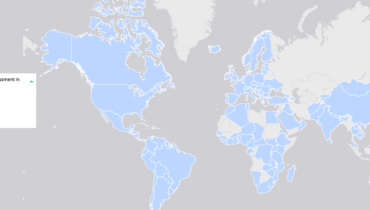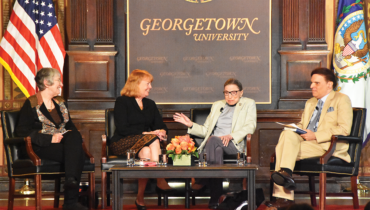Justice for women and girls is at the heart of the 2030 Agenda, with its commitment to gender equality (SDG 5) and its promise of peaceful, just and inclusive societies (SDG 16).
UN Women, IDLO and the World Bank co-convened the High-level Group on Justice for Women, along with the Pathfinders for Peaceful, Just and Inclusive Societies. The Group included a range of influencers, leaders and advocates from around the world and delivered a comprehensive report to better understand common justice problems for women, make the case for investment and identify what works.
Dr. Jeni Klugman, Managing Director of GIWPS, served as the lead author of the report. In this blog she highlights the report’s key findings and the strategies that can accelerate progress on justice for women and help deliver on the promise of SDG5 and SDG16.
Women’s justice needs are diverse, and largest for women in poverty
For too many women, gaps persist between the promise of justice and realities on the ground. Women living in poverty experience more frequent and more complex, interrelated legal problems; “intersectionality” can lead to cumulative disadvantage. In other words, every additional legal problem someone experiences increase their probability of experiencing more problems, especially people living in poverty.
The report provides a global overview of legal discriminations that exist both on paper and in practice.
- Regional outliers, in terms of unequal inheritance rights, early marriage, violence against women, and unequal property rights, include Yemen, Pakistan, and Guinea.
- Globally, more than half of women have experienced a legal problem over the past two years.
- From health to consumer issues, similar shares of women and men face civil legal problems. However, at the same time, women face more family-related legal problems and restrictions on their rights.
- In Australia, people with multiple disadvantages reported to face problems six times more than those with none.
- In countries where women’s situation is worse, overall in terms of inclusion, justice and security – countries ranking in the bottom third of the Women, Peace and Security (WPS) Index published by the Georgetown Institute of Women Peace and Security together with PRIO – a higher share of women (around 60 percent) express legal needs.
There is a strong case to invest in justice for women
Justice for women is first and foremost a basic human right, reflected in such core treaties as CEDAW, and it is critical to progress on all the SDGs.
But, investing in justice for women is not just the right thing to do. It also makes economic sense.
For the first time, this report brings together the evidence demonstrating that investing in justice for women – and especially eliminating legal barriers, reducing gender-based violence and child marriage – produces high returns to the economy and society.
We show that women’s justice, security and inclusion – as captured in the WPS Index – is strongly associated with human development.
- Ending child marriage could generate annual gains from lower population growth, for example, estimated by the World Bank and ICRW to exceed $20 billion in 2015 and $560 billion in 2030.
- Women’s land rights are associated with better outcomes on multiple economic and development fronts.
The report recognizes that while the potential gains from investments in justice for women are large, budgetary and other constraints require prioritization, especially in the short run.
Fortunately, many proven and promising actions – including eliminating discriminatory laws – should be cost-effective, relatively easy to implement and produce sizeable gains without major new spendings. However, additional resources are required to enforce existing and new laws and regulations. Other interventions — including providing affordable access to legal services for disadvantaged groups – likely require much larger budgetary commitments.
What works to advance justice for women
We framed promising approaches to women’s justice under five broad drivers.

Eliminating discriminatory laws signals that gender-based discrimination is unacceptable. Since 2013, there have been 87 changes toward legal gender equality across 65 countries.
Preventing and responding to intimate partner violence has moved to the top of the global, and in many countries, national agenda. The pace of national legislative reform on domestic violence has been rapid since 1976, when only one country prohibited marital rape – now more than ¾ countries have laws on domestic violence.
This legal reform needs to be accompanied by supportive policies and regulations, community engagement and mobilization. Strategic litigation can be a way to bring about gender-responsive interpretation and application of the law.
Overcoming disadvantage for poor and marginalized women requires targeted policies and programs. This can be done via social protection programs – the focus of this year’s CSW. Other programs include:
- Access to legal aid to enable poor people to seek justice that would be otherwise out of reach.
- Support from paralegal services.
- Promoting legal literacy to create an awareness of legal rights and duties.
Empowering women – economically and as rights holders – is part of ensuring justice for women.
- Enabling legal identity can be a stepping stone to women’s agency and empowerment. Access to some government programs are conditional on having a legal identity document.
- Strengthening women’s land rights has intrinsic and instrumental importance for both women and men. Three key areas – family law, inheritance law, and land law – affect the right to own and control property.
- Collective action as a catalyst can inform and educate people about women’s rights, provide spaces for women’s and girls’ groups, and campaign for reforms.
- Eradicating patriarchal biases in family law has been successfully pursued in many countries through feminist advocacy and women’s representation in decision-making.
Include women in decision-making at all levels in the justice sector. What works to change the pervasive under-representation of women in decision-making in the justice sector?
- Political will is of primary importance.
- Fair and transparent selection, nomination, and promotion processes.
- Influencing aspirations and mentoring women.
- Improving data and tracking progress. Most countries license attorneys and bar associations, who collect, but do not publish, demographic information.
The HLG call to action is structured around the primary drivers to enhance justice for women based on empirical evidence about what has been tried and tested and has demonstrated impact, or that which has potential, based on experience and analysis.
The focus is on women themselves – and enhancing their opportunities and outcomes. At the same time, structural changes are also often needed to make the system more accessible and people-centered.
Evidence overall suggests that multi-pronged strategies are most effective – where top-down measures, such as legal reforms, are coupled with efforts at the community level.
A key lesson is that a one-size-fits-all approach is not effective – programs must adapt to local context – and will differ among individual women and groups of women within countries.
Looking ahead…
The work of the High-level Group is epitomized in its call to action. To catalyze real change in justice for women, the members of the group and the Task Force on Justice will use the report to inspire and inform commitments and actions, especially in the lead up to the High-level Political Forum in July and the SDG Summit in September 2019.
The report Justice for Women, its executive summary and the infographic summary are available online. The report was launched during the Commission on the Status of Women (CSW63) in New York. Read more on the launch from UN Women, IDLO, the World Bank and the Pathfinders.


